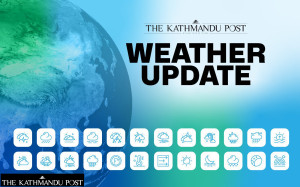Weather
Monsoon spreads across Nepal after 23 days of gradual advance
Meteorological division confirms monsoon now active in all seven provinces.
Post Report
This year’s monsoon system has spread across the entire country from Friday, according to the Meteorological Forecasting Division.
In a special weather bulletin issued today, the division said the monsoon has fully advanced across Nepal 23 days after its initial onset.
The monsoon had first entered Nepal on May 29 through the eastern region and had expanded to most parts of Koshi Province. By June 12, it had reached parts of Madhesh, Bagmati, and Gandaki provinces, as well as the eastern areas of Lumbini Province.
Meteorologist Pratima Manandhar said that with the spread of monsoon over Lumbini, Karnali, and Sudurpaschim provinces from today, the system is now active across all seven provinces.
“Currently, monsoon winds are affecting parts of Koshi, Madhesh, Bagmati, Gandaki, and eastern Lumbini,” she said. “Westerly and local winds are also partially influencing western Nepal, along with the low-pressure system formed around West Bengal in India.”
Monsoon clouds entered the country from eastern Nepal two weeks before the usual onset date of June 13. Last year, the monsoon began on June 10 and retreated on October 12 only.
The Met Department has predicted that Nepal is likely to witness above-normal monsoon rainfall this year. This has sparked optimism for better crop yields and provided a much-needed lift for the country’s struggling economy.
But the forecast also comes with a warning. Above-normal rains could spell more disasters, including flash floods and landslides.
However, some parts in the north, south, east, and northeast of South Asia are likely to witness normal to below-normal rainfall.
This year, the National Disaster Risk Reduction and Management Authority (NDRRMA) has predicted that nearly two million (1,997,731) people from 457,145 households could be affected by monsoon-related disasters.
As the Met Department has forecast above-normal rainfall in most parts of the country, the NDRRMA anticipates a higher risk of floods, landslides, inundation, excessive rain, land erosion, and flash floods.
According to the projection, the districts of Lumbini province will be affected the most in the monsoon–523,656 people from 119,830 households will be affected. This is followed by the Bagmati–327,376 people from 74,914 households, Gandaki–287,107 people from 65,699 households, Koshi 275,867 people from 63,127 households, Madhesh–228,687 people from 52,331 households, Sudurpaschim–227,730 people from 52,112 households, and Karnali province–127,308 people from 29,132 households.
Nepal is one of the world’s most vulnerable countries to the climate crisis and has witnessed extreme weather events over the past decade and a half. The weather has turned more unusual and destructive in the past couple of years.
Evidence suggests that the maximum temperature in Nepal is rising at a greater rate (0.056 degrees Celsius per year) than the global average of 0.03 degrees Celsius per year.
Experts say extreme weather events–excess rainfall in a short period, continuous rains for several days after the monsoon, dry spells, droughts, below-average precipitation, and above-normal winter temperatures–have become more frequent in Nepal. They have asked authorities concerned to start preparation for the worst case scenario of monsoon disasters.




 22.22°C Kathmandu
22.22°C Kathmandu





